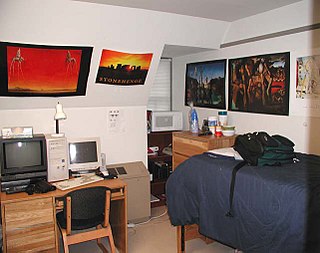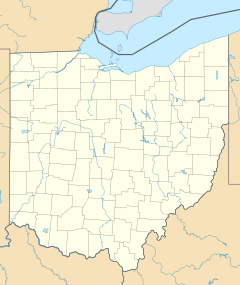
Oberlin College is a private liberal arts college and conservatory of music in Oberlin, Ohio. Founded in 1833, it is the oldest coeducational liberal arts college in the United States and the second-oldest continuously operating coeducational institute of higher learning in the world. The Oberlin Conservatory of Music is the oldest continuously operating conservatory in the United States. In 1835, Oberlin became one of the first colleges in the United States to admit African Americans, and in 1837, the first to admit women. It has been known since its founding for progressive student activism.

Oberlin is a city in Lorain County, Ohio, United States. It is located about 31 miles (50 km) southwest of Cleveland within the Cleveland metropolitan area. The population was 8,555 at the 2020 census. Oberlin is the home of Oberlin College, a liberal arts college and music conservatory with approximately 3,000 students.

A dormitory is a building primarily providing sleeping and residential quarters for large numbers of people such as boarding school, high school, college or university students. In some countries, it can also refer to a room containing several beds accommodating people.

Mixed-sex education, also known as mixed-gender education, co-education, or coeducation, is a system of education where males and females are educated together. Whereas single-sex education was more common up to the 19th century, mixed-sex education has since become standard in many cultures, particularly in Western countries. Single-sex education remains prevalent in many Muslim countries. The relative merits of both systems have been the subject of debate.

Elmira College is a private college in Elmira, New York. Founded as a college for women in 1855, it is the oldest existing college granting degrees to women that were the equivalent of those given to men. Elmira College became coeducational in all of its programs in 1969. As of 2023, the college has an enrollment of approximately 850 students.

Johnson C. Smith University (JCSU) is a private historically black university in Charlotte, North Carolina. It is affiliated with the Presbyterian Church (USA) and accredited by the Southern Association of Colleges and Schools (SACS). The university awards Bachelor of Science, Bachelor of Arts, Bachelor of Social Work, and Master of Social Work degrees.

Reinhardt University is a private university in Waleska, Georgia. The university has an off-campus center in Alpharetta and offers some programs in Cartersville, Marietta, and Canton, and online. Reinhardt is affiliated with the United Methodist Church.

Seaview Terrace, also known as the Carey Mansion, is a privately owned mansion located in Newport, Rhode Island. It was designed in the Châteauesque style based on the French chateaux of the 16th century, and completed in 1925. It was the last of the great "Summer Cottages" constructed and is the fifth-largest of Newport's mansions, after The Breakers, Ochre Court, Belcourt Castle, and Rough Point. The television show Dark Shadows used its exterior as the fictional Collinwood Mansion. Part of the main house and some of the outbuildings were leased to Salve Regina University until recently.
A student housing cooperative, also known as co-operative housing, is a housing cooperative for student members. Members live in alternative cooperative housing that they personally own and maintain. These houses are designed to lower housing costs while providing an educational and community environment for students to live and grow in. They are, in general, nonprofit, communal, and self-governing, with students pooling their monetary and personal resources to create a community style home. Many student housing cooperatives share operation and governing of the house. As with most cooperatives, student housing coops follow the Rochdale Principles and promote collaboration and community work done by the members for mutual benefit.

The James Hornsby School is a co-educational secondary school located in Laindon, in the Borough of Basildon, Essex, England. It was formed from the merger in 1998 of the Laindon School and Nicholas Comprehensive, and occupies the site of the latter.
St. Peter's School is a private all-boys boarding school located in the town of Panchgani in Satara, Maharashtra, India. Founded in 1902, it ranks among the top ten boarding schools in India. The school campus covers an area of approximately 58 acres (23 ha) in the hilly countryside of Western India. It is essentially a boarding school, but a few day scholars are also admitted.

Rev. John Keep was a trustee of Oberlin College from 1834 to 1870. Keep and William Dawes toured England in 1839 and 1840 gathering funds for Oberlin College in Ohio. They both attended the 1840 anti-slavery convention in London.

The Ravenna Kibbutz was a nondenominational Jewish intentional community from 2007–2012 located in the Ravenna neighborhood of Seattle. Its three rented houses and one apartment were home to 15 resident-organizers, who plan public programs such as Shabbat dinners and Jewish movie nights. The Kibbutz's ideology was not communistic; it was not a true commune but simply an example of cohousing. The Pacific Northwest contains many cohousing communities and a wide variety of Jewish organizations, but thus far the region has no other Jewish cohousing community.
Edinburgh College is a private co-educational early leaning, primary and secondary day school, located in the outer-eastern Melbourne suburb of Lilydale, Victoria, Australia. The school is operated by the Seventh-day Adventist Church and was formerly two separate schools: Lilydale Adventist Academy and Edinburgh Adventist Primary School. It is a part of the Seventh-day Adventist education system, the world's second largest Christian school system.

Bishop Hall is an academic, administrative, and residence building, housing co-ed upperclassmen residents of Miami University in Oxford, Ohio.

The Oberlin Student Cooperative Association (OSCA) is a non-profit corporation founded in 1962 that feeds and houses Oberlin College students. Located in the town of Oberlin, Ohio, it is independent from but closely tied to Oberlin College. OSCA is the second-largest student housing cooperative in North America, with the largest per-capita of any student co-op.

Central Philippine Adventist College is private coeducational Christian college in Alegria, Murcia, Negros Occidental, Philippines. It is a part of the Seventh-day Adventist education system, the world's second largest Christian school system. The college is fully accredited by the Association of Christian Schools, Colleges and Universities-Accrediting Agency, Inc. (ACSCU-AAI), the Adventist Accrediting Agency (AAA) of General Conference of the Seventh-day Adventist Church and by the Department of Education of Southern Asia Pacific Division.

George Feick was a German-American builder in Sandusky and Oberlin, Ohio. His works include the Wyoming State Capitol, multiple buildings at Oberlin College, and numerous office buildings, churches, schools, libraries and residences in and around Sandusky. Several of his works are listed on the National Register of Historic Places.

Tappan Square is a public park and National Historic Landmark at the center of Oberlin, Ohio. The park initially opened in 1885, on 13 acres (5.3 ha) of city-owned land at the bequest of Oberlin College benefactor Charles Martin Hall. It was designed by the esteemed duo of Frederick Law Olmsted Jr. and John Charles Olmsted. The square in Oberlin was named in the 1940s, in honor of Arthur and Lewis Tappan, wealthy merchants of New York City who supported Oberlin College in its early days and who were ardent abolitionists. The square was previously known as College Park or the Campus. Until 1965 it held the Historic Elm, under which John Jay Shipherd and Philo Stewart were said to have knelt and prayed to God and on which spot they decided to found the town. The square held college buildings for many years, including a five-story brick college classroom and men's dormitory called Tappan Hall. As the buildings on the square grew older, the area was cleaned up as a green space for the community, removing the buildings, in accordance with the provisions of the will of Charles Martin Hall.

Tank Hall, also known as Tank House and Tank Cooperative, is an 1897 Queen Anne living and dining cooperative owned and maintained by Oberlin College in Oberlin, Ohio, United States. Originally the Tank Home for Missionary Children, the house underwent a series of renovations before becoming the co-op it is today. In 1962, it became the property of Oberlin Student Cooperative Association, the second largest student cooperative in the United States.



















